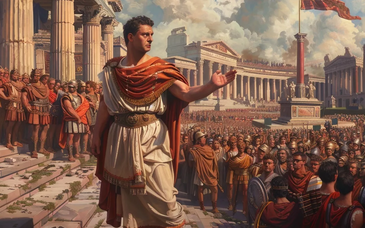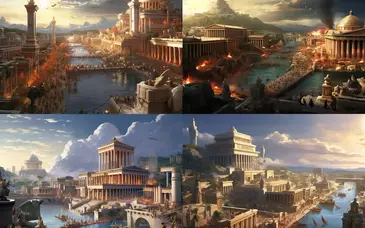The Carthaginians had not lost everything, though they had been driven out of waters where they had collided with Greeks and increasingly with Italian traders also.
There were two paths still open to them. their original exploitation of Africa, both the mountainous north and the oases and caravan routes towards the Niger basin, in the first place and the development of trade in the farther west of the Mediterranean. Conservative managers were prepared to be content with Africa, relying on mutually advantageous trade with their late enemies, to make good their losses of oversea territory. Hamilcar Barca on the other hand was for the bolder plan of forestalling Greek and Roman alike in Spain, while that was still possible.
Spain, to which Hamilcar now turned (238 BC), with the sceptical and lukewarm agreement of the Carthaginian government, was a new, rugged and barbarous country which held great promise. The northwest boasted metal-yielding highlands, to the northeast lay the wide Iberus (Ebro) valley, which gave its ancient name to the whole Iberian peninsula. And in the south lay highlands and the Balearic isles very rich in copper and other ores, as well as the valley of the Guadalquivir river with its almost tropical fertility.
Whereas former explorers, both Phoenician and Greek, had made Gades (Cadiz) their headquarters, Hamilcar's wider designs required a more accessible and also more defensible base. This he found in a detached spur of the south-eastern range where 'New Carthage' was founded and modern Cartagena still bears its name. How this new city flourished, and what success Hamilcar had in conciliating native peoples and exploiting natural wealth, is evident from the treaty which was drafted after Hamilcar's death in 228 BC, between his son-in-law Hasdrubal and the Romans, by which the Ebro river was to be recognized as the defining border between their relative spheres of influence.
As Rome, though busy enough since the First Punic War along her northern frontiers, had no footing yet beyond the Apennines, this Ebro frontier clearly represented only the reasonable claims of Massilia and other old Phocean settlements. But it illustrates the indifference with which responsible people in Carthage regarded Hamilcar's doings, that this agreement seems to neither have been rejected nor confirmed. And certainly the Romans made no secret, a few years later, of their alliance with Saguntum, which lay nearly a hundred miles south of the river Ebro, and moreover was of strategic importance to the rich coastal plain of Valencia. The date of this alliance is unknown, so it is unclear if it had been signed earlier or later than Hasdrubal's agreement.
Eight years after the treaty between Carthage and Rome, in 220 BC, all the native peoples of Spain up to the agreed border had been subjugated by the Carthaginians. Only Saguntum remained not only independent but positively allied with Rome. Hasdrubal was dead.
In 221 BC had been murdered by a slave whose master he'd had put to death. Hannibal, the son of Hamilcar Barca, had succeeded to Hasdrubal's command.
Hannibal had been made to vow in childhood to hate the Romans. It was obvious that his succession could only lead to trouble with Rome. In fact, wise heads in Carthage had done what they could to prevent his succession to the Spanish viceroyalty. But the Carthaginian army worshipped him and would accept no-one else. The Spanish venture had been throughout a personal enterprise of his family. There was no obligation to support Hannibal, and in case of trouble he could be disowned.
It seems certain that Carthage itself did not want another war with Rome.
Nor did the Romans want one. Since the treaty with Hasdrubal they had been forced to undertake campaigns against renewed aggression by the Gauls. They had been forced to occupy territory as far as the Po, to found colonies at Placentia and Cremona, for the defence of the passage of this river, and to raid beyond it as far as Mediolanum (Milan). The great Flaminian Road had just been carried forward to the Adriatic coast to ensure communication with their new conquests. They had had little wars in Liguria and also in Istria, and in 221 BC their whole field force was in Illyria across the Adriatic destroying the league of pirates which had been harrying the east coast of Italy.
The significance of the Illyrian affair is not to be overlooked. Piracy had long been rife in the Adriatic Sea, with which until recently Rome had scarcely been concerned. But the Punic war had left left her with a fleet it otherwise would hardly have acquired. And she now used her newly acquired power to best of her ability. In suppressing the Illyrian pirateering power, Rome appeared as the protector of Greek commerce, a champion of Greek interests against the barbarians. And by doing so Rome was preparing the states of Greece to turn to her as protector against Macedon.
All these operations tended to consolidate the Roman power in Italy.
But for Rome they had been costly and exhausting. And the last thing she desired was to be forced into a war likely to prove still more costly and still more exhausting, of which the issue would be extremely doubtful.
Accordingly, when the news reached Rome that Hannibal was attacking Saguntum, the Romans sent him only a formal protest. And when this was ignored, took up the affair with the responsible government of Carthage. Here opinion was divided. One party wished to surrender Hannibal and compensate Rome, but Hannibal's friends prevailed. And while the Carthaginians debated, Hannibal succeeded in taken the city.
This disunity and lukewarm support for Hannibal among the Carthaginians was a factor which should prove decisive in the war to come.
When the Roman envoys arrived, their message to Carthage was simple - 'Peace or war, as you choose.'
The Carthaginian government tried to argue about details of the treaty of 228 BC and its conflict with Rome's separate alliance with Saguntum. But the Roman envoys' position remained the same, - 'Peace or war, as you choose.'
And as the peace was broken, war it was.



